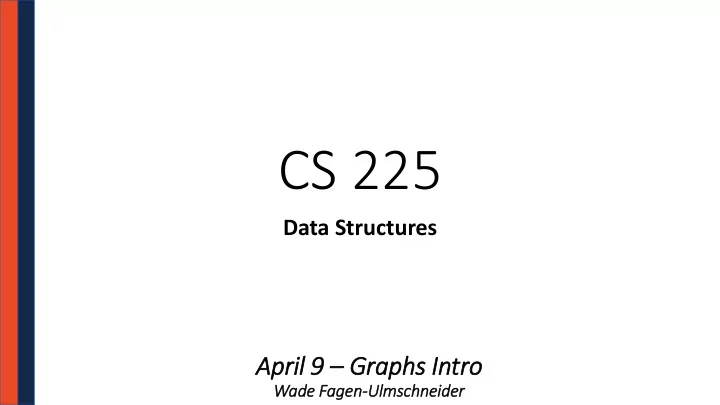

CS 225 Data Structures April 9 – Graphs In Intro Wad ade Fag agen-Ulm lmschneid ider
Disjoint Sets Analysis The iterated log function: The number of times you can take a log of a number. log*(n) = 0 , n ≤ 1 1 + log*(log(n)) , n > 1 What is lg*(2 65536 ) ?
Disjoint Sets Analysis In an Disjoint Sets implemented with smart unions and path compression on find : Any sequence of m union and find operations result in the worse case running time of O( ____________ ), where n is the number of items in the Disjoint Sets.
In Review: Data Structures In List Array - Doubly Linked List - Sorted Array - Skip List - Unsorted Array - Trees - Stacks - BTree - Queues - Binary Tree - Hashing - Huffman Encoding - Heaps - kd-Tree - Priority Queues - AVL Tree - UpTrees - Disjoint Sets
Array [0] [1] [2] [3] [4] [5] [6] [7] • Constant time access to any element, given an index a[k] is accessed in O(1) time, no matter how large the array grows • Cache-optimized Many modern systems cache or pre-fetch nearby memory values due the “Principle of Locality”. Therefore, arrays often perform faster than lists in identical operations.
Array [0] [1] [2] [3] [4] [5] [6] [7] Sorted Array [0] [1] [2] [3] [4] [5] [6] [7] • Efficient general search structure Searches on the sort property run in O(lg(n)) with Binary Search • Inefficient insert/remove Elements must be inserted and removed at the location dictated by the sort property, resulting shifting the array in memory – an O(n) operation
Array [0] [1] [2] [3] [4] [5] [6] [7] Unsorted Array [0] [1] [2] [3] [4] [5] [6] [7] • Constant time add/remove at the beginning/end Amortized O(1) insert and remove from the front and of the array Idea: Double on resize • Inefficient global search structure With no sort property, all searches must iterate the entire array; O(1) time
Arr rray [0] [1] [2] [3] [4] [5] [6] [7] Unsorted Arr rray [0] [1] [2] [3] [4] [5] [6] [7] Queue (FIFO) [0] [1] [2] [3] [4] [5] [6] [7] • First In First Out (FIFO) ordering of data Maintains an arrival ordering of tasks, jobs, or data • All ADT operations are constant time operations enqueue() and dequeue() both run in O(1) time
Arr rray [0] [1] [2] [3] [4] [5] [6] [7] Unsorted Arr rray [0] [1] [2] [3] [4] [5] [6] [7] Stack (LIFO) [0] [1] [2] [3] [4] [5] [6] [7] • Last In First Out (LIFO) ordering of data Maintains a “most recently added” list of data • All ADT operations are constant time operations push() and pop() both run in O(1) time
In Review: Data Structures In List Array - Doubly Linked List - Sorted Array - Skip List - Unsorted Array - Trees - Stacks - BTree - Queues - Binary Tree - Hashing - Huffman Encoding - Heaps - kd-Tree - Priority Queues - AVL Tree - UpTrees - Disjoint Sets
In In Review: Data Structures List Array - Doubly Linked List - Sorted Array - Skip List - Unsorted Array Graphs - Trees - Stacks - BTree - Queues - Binary Tree - Hashing - Huffman Encoding - Heaps - kd-Tree - Priority Queues - AVL Tree - UpTrees - Disjoint Sets
“ When you're asked about kd-trees in an interview and Wade comes to mind :”
The Internet, 2003 The OPTE Project (2003) Map of the entire internet; nodes are routers; edges are connections.
Who’s the real main character in Shakespearean tragedies? Martin Grandjean (2016) https://www.pbs.org/newshour/arts/whos-the-real-main-character-in- shakespearen-tragedies-heres-what-the-data-say
“Rush Hour” Solution Unknown Source Presented by Cinda Heeren, 2016
Wolfram|Alpha's "Personal Analytics“ for Facebook Generated: April 2013 using Wade Fagen- Ulmschneider’s Profile Data
This graph can be used to quickly calculate whether a given number is divisible by 7. 1. Start at the circle node at the top. 2. For each digit d in the given number, follow d blue (solid) edges in succession. As you move from one digit to the next, follow 1 red (dashed) edge. 3. If you end up back at the circle node, your number is divisible by 7. 3703 “Rule of 7” Unknown Source Presented by Cinda Heeren, 2016
Conflict-Free Final Exam Scheduling Graph Unknown Source Presented by Cinda Heeren, 2016
Class Hierarchy At University of Illinois Urbana-Champaign A. Mori, W. Fagen-Ulmschneider, C. Heeren Graph of every course at UIUC; nodes are courses, edges are prerequisites http://waf.cs.illinois.edu/discovery/class_hi erarchy_at_illinois/
MP Collaborations in CS 225 Unknown Source Presented by Cinda Heeren, 2016
“Stanford Bunny” Greg Turk and Mark Levoy (1994)
Graphs To study all of these structures: 1. A common vocabulary 2. Graph implementations 3. Graph traversals 4. Graph algorithms
Incident Edges: Graph Vocabulary ry I(v) = { (x, v) in E } Degree(v): |I| G = (V, E) |V| = n Adjacent Vertices: |E| = m (2, 5) A(v) = { x : (x, v) in E } Path(G 2 ): Sequence of vertices connected by edges Cycle(G 1 ): Path with a common begin and end vertex. G 3 Simple Graph(G): A graph with G 2 no self loops or multi-edges. G 1
Subgraph(G): Graph Vocabulary ry G’ = (V’, E’) : V’ ∈ V, E’ ∈ E, and G = (V, E) (u, v) ∈ E u ∈ V’, v ∈ V’ |V| = n |E| = m (2, 5) Complete subgraph(G) Connected subgraph(G) Connected component(G) Acyclic subgraph(G) Spanning tree(G) G 3 G 2 G 1
Running times are often reported by n , the number of vertices, but often depend on m , the number of edges. How many edges? Minimum edges: Not Connected: V Connected*: b a d U X Z h c e Maximum edges: W g Simple: f Y Not simple:
Recommend
More recommend